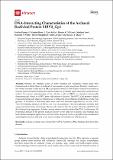Files in this item
DNA‐Interacting characteristics of the archaeal Rudiviral protein SIRV2_Gp1
Item metadata
| dc.contributor.author | Peeters, Eveline | |
| dc.contributor.author | Boon, Maarten | |
| dc.contributor.author | Rollie, Clare Jane Catherine | |
| dc.contributor.author | Willaert, Ronnie G. | |
| dc.contributor.author | Voet, Marleen | |
| dc.contributor.author | White, Malcolm Frederick | |
| dc.contributor.author | Prangishvili, David | |
| dc.contributor.author | Lavigne, Rob | |
| dc.contributor.author | Quax, Tessa E. F. | |
| dc.date.accessioned | 2017-07-18T15:30:10Z | |
| dc.date.available | 2017-07-18T15:30:10Z | |
| dc.date.issued | 2017-07 | |
| dc.identifier | 250537150 | |
| dc.identifier | 9570f000-93ef-4f03-86f7-a408774a9063 | |
| dc.identifier | 85025625256 | |
| dc.identifier | 000406684400032 | |
| dc.identifier.citation | Peeters , E , Boon , M , Rollie , C J C , Willaert , R G , Voet , M , White , M F , Prangishvili , D , Lavigne , R & Quax , T E F 2017 , ' DNA‐Interacting characteristics of the archaeal Rudiviral protein SIRV2_Gp1 ' , Viruses , vol. 9 , no. 7 , 190 . https://doi.org/10.3390/v9070190 | en |
| dc.identifier.issn | 1999-4915 | |
| dc.identifier.other | ORCID: /0000-0003-1543-9342/work/47136109 | |
| dc.identifier.uri | https://hdl.handle.net/10023/11250 | |
| dc.description.abstract | Whereas the infection cycles of many bacterial and eukaryotic viruses have been characterized in detail, those of archaeal viruses remain largely unexplored. Recently, studies on a few model archaeal viruses such as SIRV2 (Sulfolobus islandicus rod‐shaped virus) have revealed an unusual lysis mechanism that involves the formation of pyramidal egress structures on the host cell surface. To expand understanding of the infection cycle of SIRV2, we aimed to functionally characterize gp1, which is a SIRV2 gene with unknown function. The SIRV2_Gp1 protein is highly expressed during early stages of infection and it is the only protein that is encoded twice on the viral genome. It harbours a helix‐turn‐helix motif and was therefore hypothesized to bind DNA. The DNA‐binding behavior of SIRV2_Gp1 was characterized with electrophoretic mobility shift assays and atomic force microscopy. We provide evidence that the protein interacts with DNA and that it forms large aggregates, thereby causing extreme condensation of the DNA. Furthermore, the N‐terminal domain of the protein mediates toxicity to the viral host Sulfolobus. Our findings may lead to biotechnological applications, such as the development of a toxic peptide for the containment of pathogenic bacteria, and add to our understanding of the Rudiviral infection cycle. | |
| dc.format.extent | 13 | |
| dc.format.extent | 3832102 | |
| dc.language.iso | eng | |
| dc.relation.ispartof | Viruses | en |
| dc.subject | Archaea | en |
| dc.subject | Archaeal virus | en |
| dc.subject | Rudiviridae | en |
| dc.subject | SIRV2 | en |
| dc.subject | Solfolobus | en |
| dc.subject | DNA binding | en |
| dc.subject | Helix-turn-helix doman | en |
| dc.subject | QH301 Biology | en |
| dc.subject | QR355 Virology | en |
| dc.subject | NDAS | en |
| dc.subject.lcc | QH301 | en |
| dc.subject.lcc | QR355 | en |
| dc.title | DNA‐Interacting characteristics of the archaeal Rudiviral protein SIRV2_Gp1 | en |
| dc.type | Journal article | en |
| dc.contributor.sponsor | BBSRC | en |
| dc.contributor.institution | University of St Andrews. School of Biology | en |
| dc.contributor.institution | University of St Andrews. Biomedical Sciences Research Complex | en |
| dc.identifier.doi | https://doi.org/10.3390/v9070190 | |
| dc.description.status | Peer reviewed | en |
| dc.identifier.grantnumber | BB/M021017/1 | en |
This item appears in the following Collection(s)
Items in the St Andrews Research Repository are protected by copyright, with all rights reserved, unless otherwise indicated.

